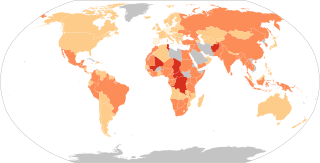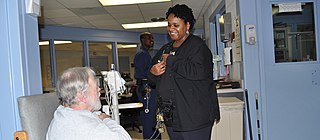Related Research Articles

The hymen is a thin piece of mucosal tissue that surrounds or partially covers the vaginal opening. A small percentage are born with hymens that are imperforate and completely obstruct the vaginal canal. It forms part of the vulva and is similar in structure to the vagina. The term comes straight from the Greek, for 'membrane'.
Sexual assault is an act in which one intentionally sexually touches another person without that person's consent, or coerces or physically forces a person to engage in a sexual act against their will. It is a form of sexual violence that includes child sexual abuse, groping, rape, drug facilitated sexual assault, and the torture of the person in a sexual manner.
A rape kit or rape test kit is a package of items used by medical, police or other personnel for gathering and preserving physical evidence following an instance or allegation of sexual assault. The evidence collected from the victim can aid the criminal rape investigation and the prosecution of a suspected assailant. DNA evidence can have tremendous utility for sexual assault investigations and prosecution by identifying offenders, revealing serial offenders through DNA matches across cases, and exonerating those who have been wrongly accused.
Pediatric nursing is part of the nursing profession, specifically revolving around the care of neonates and children up to adolescence. The word, pediatrics, comes from the Greek words 'paedia' (child) and 'iatrike' (physician). 'Paediatrics' is the British/Australian spelling, while 'pediatrics' is the American spelling.
Elissa Panush Benedek is an American psychiatrist specializing in child and adolescent psychiatry and forensic psychiatry. She is an adjunct clinical professor of psychiatry at the University of Michigan Medical Center. She served as director of research and training at the Center for Forensic Psychiatry in Ann Arbor for 25 years and was president of the American Psychiatric Association from 1990 to 1991. She is regarded as an expert on child abuse and trauma, and has testified in high-profile court cases. She also focuses on ethics, psychiatric aspects of disasters and terrorism, and domestic violence. In addition to her own books, book chapters, and articles, she has collaborated with her husband, attorney Richard S. Benedek, on studies of divorce, child custody, and child abuse.
An advanced practice nurse (APN) is a nurse with post-graduate education and training in nursing. Nurses practicing at this level may work in either a specialist or generalist capacity. APNs are prepared with advanced didactic and clinical education, knowledge, skills, and scope of practice in nursing.
Nursing credentials and certifications are the various credentials and certifications that a person must have to practice nursing legally. Nurses' postnominal letters reflect their credentials—that is, their achievements in nursing education, licensure, certification, and fellowship. The letters usually appear in the following order:

Nursing in the United States is a professional health care occupation. It is the largest such occupation, employing millions of certified professionals. As of 2023, 3,175,390 registered nurses were employed, paid a median income of $86,070.

Rape is a type of sexual assault involving sexual intercourse or other forms of sexual penetration carried out against a person without their consent. The act may be carried out by physical force, coercion, abuse of authority, or against a person who is incapable of giving valid consent, such as one who is unconscious, incapacitated, has an intellectual disability, or is below the legal age of consent. The term rape is sometimes used interchangeably with the term sexual assault.

Emergency nursing is a specialty within the field of professional nursing focusing on the care of patients who require prompt medical attention to avoid long-term disability or death. In addition to addressing "true emergencies," emergency nurses increasingly care for people who are unwilling or unable to get primary medical care elsewhere and come to emergency departments for help. In fact, only a small percentage of emergency department (ED) patients have emergency conditions such as a stroke, heart attack or major trauma. Emergency nurses also tend to patients with acute alcohol and/or drug intoxication, psychiatric and behavioral problems and those who have been raped.
In the United States, a psychiatric-mental health nurse practitioner (PMHNP) is an advanced practice registered nurse trained to provide a wide range of mental health services to patients and families in a variety of settings. PMHNPs diagnose, conduct therapy, and prescribe medications for patients who have psychiatric disorders, medical organic brain disorders or substance abuse problems. They are licensed to provide emergency psychiatric services, psychosocial and physical assessments of their patients, treatment plans, and manage patient care. They may also serve as consultants or as educators for families and staff. The PMHNP has a focus on psychiatric diagnosis, including the differential diagnosis of medical disorders with psychiatric symptoms, and on medication treatment for psychiatric disorders.

As sexual violence affects all parts of society, the responses that arise to combat it are comprehensive, taking place on the individual, administrative, legal, and social levels.
A psychiatric assessment, or psychological screening, is the process of gathering information about a person within a psychiatric service, with the purpose of making a diagnosis. The assessment is usually the first stage of a treatment process, but psychiatric assessments may also be used for various legal purposes. The assessment includes social and biographical information, direct observations, and data from specific psychological tests. It is typically carried out by a psychiatrist, but it can be a multi-disciplinary process involving nurses, psychologists, occupational therapist, social workers, and licensed professional counselors.

Nursing is a health care profession that "integrates the art and science of caring and focuses on the protection, promotion, and optimization of health and human functioning; prevention of illness and injury; facilitation of healing; and alleviation of suffering through compassionate presence". Nurses practice in many specialties with varying levels of certification and responsibility. Nurses comprise the largest component of most healthcare environments. Shortages of qualified nurses are found in many countries.
Rape investigation is the procedure to gather facts about a suspected rape, including forensic identification of a perpetrator, type of rape and other details.
A Sexual Assault Nurse Examiner (SANE) is a qualification for forensic nurses who have received special training to conduct sexual assault evidentiary exams for rape victims in the United States.

Patient-initiated violence is a specific form of workplace violence that affects healthcare workers that is the result of verbal, physical, or emotional abuse from a patient or family members of whom they have assumed care. Nurses represent the highest percentage of affected workers; however, other roles include physicians, therapists, technicians, home care workers, and social workers. Non clinical workers are also assaulted, for example, security guards, cleaners, clerks, technicians. The Occupational Safety and Health Administration used 2013 Bureau of Labor Statistics and reported that healthcare workplace violence requiring days absent from work from patients represented 80% of cases. In 2014, a survey by the American Nurses Association of 3,765 nurses and nursing students found that 21% reported physical abuse, and over 50% reported verbal abuse within a 12-month period. Causes for patient outbursts vary, including psychiatric diagnosis, under the influence of drugs or alcohol, or subject to a long wait time. Certain areas are more at risk for this kind of violence including healthcare workers in psychiatric settings, emergency or critical care, or long-term care and dementia units.

Ann C. Wolbert Burgess is an American researcher whose work has focused on developing ways to assess and treat trauma in rape victims. She is a professor at the William F. Connell School of Nursing at Boston College.

Correctional nursing or forensic nursing is nursing as it relates to prisoners. Nurses are required in prisons, jails, and detention centers; their job is to provide physical and mental healthcare for detainees and inmates. In these correctional settings, nurses are the primary healthcare providers. These nurses also work with crime victims and assist in expert witness testimonies, and are involved in a variety of legal cases, including paternity disputes and workplace injuries.
Sexual trauma therapy is medical and psychological interventions provided to survivors of sexual violence aiming to treat their physical injuries and cope with mental trauma caused by the event. Examples of sexual violence include any acts of unwanted sexual actions like sexual harassment, groping, rape, and circulation of sexual content without consent.
References
- ↑ 5. Lynch VA. Clinical forensic nursing: A descriptive study in role development. Thesis. University of Texas Arlington; 1991.
- ↑ Speck, P.M. and S. Peters, Forensic nursing: Where law and nursing intersect, in Advance for Nurse Practitioners. 1999. p. 10.
- ↑ Volz, Faugno, Mitchell, Arndt, & Speck (2022). History of the role of forensic nursing in the United States [Chapter 1, pp. 15-18]. In Introduction to Forensic Nursing Principles and Practice, Eds. Faugno, Mitchell, Sievers, Pederson, Volz, & Speck. STM Learning, St. Louis.
- 1 2 Hammer, Rita; Moynihan, Barbara; Pagliano, Elaine (2011-06-05). Forensic Nursing: a Handbook for Practice. Jones & Bartlett Publishers. ISBN 9780763792008 . Retrieved 2015-08-15.
- ↑ Jessie Liu, Harvard College, Class of 2024 A.B. in History and Science, Medicine and Society Track | Secondary in Mind, Brain, and Behavior | Faculty of Arts and Sciences (425) 442-6683 | jessieliu@college.harvard.edu |
- ↑ Burgess, A. W., Berger, A. D., & Boersma, R. R.. (2004). Forensic Nursing. The American Journal of Nursing, 104(3), 58–64. Retrieved from https://www.jstor.org/stable/29745577
- 1 2 Esposito, Lisa (2014-08-07). "How Forensic Nurses Help Assault Survivors". U.S. News & World Report. Retrieved 2015-08-15.
- ↑ Blanchard, Bobby (2015-03-10). "A&M Hopes to Add Department of Forensic Nursing". The Texas Tribune. Retrieved 2015-08-15.
- ↑ Carson, Ilona (2015-05-12). "Demand for forensic nurses on the rise in Houston". ABC 13 Eyewitness News. Retrieved 2015-08-15.
- ↑ Faugno, etal, 2022
- ↑ Berishaj K, Boyland CM, Reinink K, Lynch V. Forensic Nurse Hospitalist: The comprehensive role of the forensic nurse in a hospital setting. J Emerg Nurs. 2020;46(3):286-293. doi:10.1016/j.jen.2020.03.002
- 1 2 Stephen Lazoritz, Katherine Rossiter, & Dina Whiteaker, What every nurse needs to know about the clinical aspects of child abuse , 2010
- ↑ Services, Department of Health & Human. "Child abuse - reporting procedures". www.betterhealth.vic.gov.au. Retrieved 2016-03-29.
- ↑ "Reporting Child Abuse and Neglect - Child Welfare Information Gateway". www.childwelfare.gov. Retrieved 2016-04-22.
- ↑ Moore, G., DNP, WHNP-BC. (2015). Sexual Assault Screening in the Outpatient Setting. American Nurses Today,10(8). Retrieved March 25, 2016
- ↑ "What Is a Rape Kit? | RAINN | Rape, Abuse and Incest National Network". rainn.org. Retrieved 2016-03-29.
- ↑ "Certification Opportunities". International Association of Forensic Nurses. Archived from the original on March 20, 2018. Retrieved February 27, 2015.
- ↑ Mason, T.; Lovell, A.; Coyle, D. (2008). "Forensic psychiatric nursing: skills and competencies: I role dimensions". Journal of Psychiatric and Mental Health Nursing. 15 (2): 118–130. doi:10.1111/j.1365-2850.2007.01191.x. PMID 18211559 . Retrieved 2015-08-15.
- ↑ Zytaruk, Tom (2015-06-04). "FORENSIC NURSES: 'We can't change their lives but we can help.'". Surrey Now. Archived from the original on 2015-08-25. Retrieved 2015-08-15.